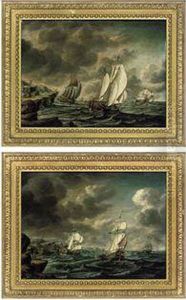Pieter Jochums Lofvers Paintings
Pieter Jochums Lofvers is an artist about whom very little is known, including his birth and death dates. This scarcity of information is not uncommon for many artists, particularly those who may not have achieved widespread fame or whose work was not extensively documented during their lifetime. Lofvers is believed to be a Dutch painter, a reasonable assumption given the Dutch origin of his name and the style of his known works, which fits within the broader context of Dutch painting.
The lack of comprehensive records about Pieter Jochums Lofvers' life and career means that we must rely largely on his extant artworks to understand his contributions to the art world. What can be inferred from the works attributed to him is that he was active during the Dutch Golden Age of painting, which spanned the 17th century. This period was characterized by a great diversity of genres, including landscape, still life, and genre painting, as well as a high volume of artistic production.
Lofvers' work, as it is currently known, includes a mix of genre scenes and landscapes. Genre scenes were a popular subject in Dutch Golden Age painting, often depicting everyday life and activities with a keen eye for detail and a moralizing or humorous undertone. Lofvers' landscapes, on the other hand, would have been part of a tradition that included artists like Jacob van Ruisdael and Meindert Hobbema, who were known for their dramatic and atmospheric depictions of the Dutch countryside.
Without specific dates or more extensive records of his life, it is challenging to place Lofvers precisely within the timeline of his contemporaries or to assess his influence on subsequent artists. However, any artist working during the Dutch Golden Age would have been part of a vibrant and influential cultural movement that had a lasting impact on the course of Western art history.
In summary, while Pieter Jochums Lofvers remains an enigmatic figure due to the limited information available about his life and career, his existing works suggest that he was part of the rich tapestry of Dutch Golden Age painting. His contributions, though perhaps not as well-recognized as those of his famous peers, offer valuable insights into the artistic practices and cultural milieu of his time.
